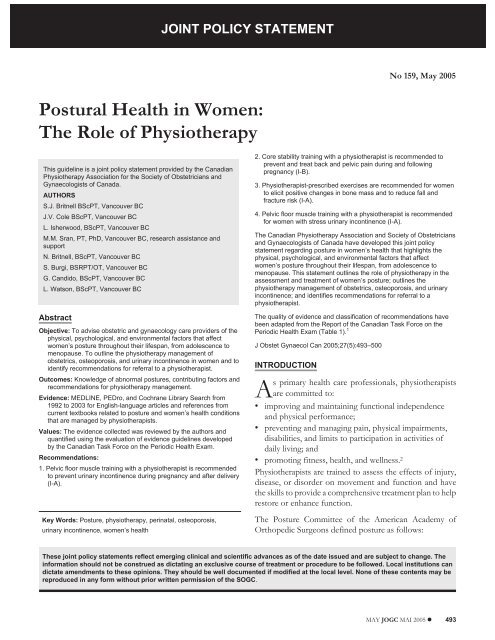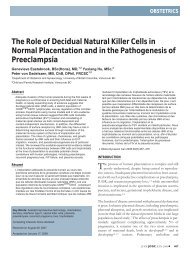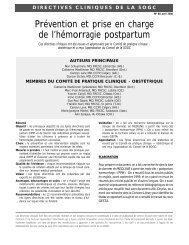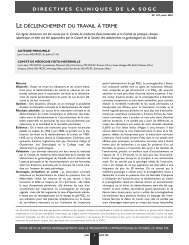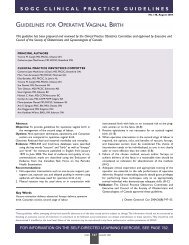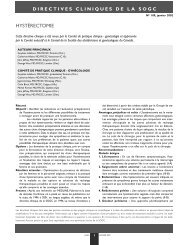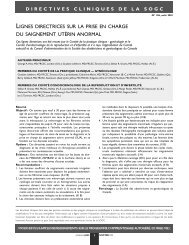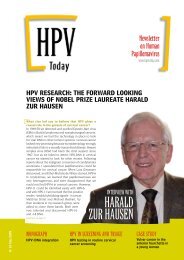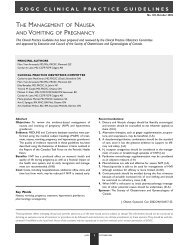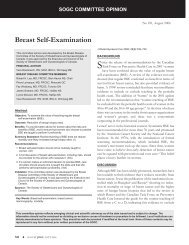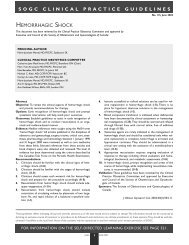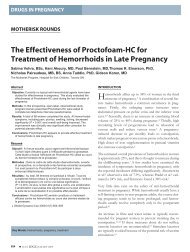Postural Health in Women: The Role of Physiotherapy - SOGC
Postural Health in Women: The Role of Physiotherapy - SOGC
Postural Health in Women: The Role of Physiotherapy - SOGC
You also want an ePaper? Increase the reach of your titles
YUMPU automatically turns print PDFs into web optimized ePapers that Google loves.
jo<strong>in</strong>t policy statement<br />
<strong>Postural</strong> <strong>Health</strong> <strong>in</strong> <strong>Women</strong>:<br />
<strong>The</strong> <strong>Role</strong> <strong>of</strong> <strong>Physiotherapy</strong><br />
This guidel<strong>in</strong>e is a jo<strong>in</strong>t policy statement provided by the Canadian<br />
<strong>Physiotherapy</strong> Association for the Society <strong>of</strong> Obstetricians and<br />
Gynaecologists <strong>of</strong> Canada.<br />
AUTHORS<br />
S.J. Britnell BScPT, Vancouver BC<br />
J.V. Cole BScPT, Vancouver BC<br />
L. Isherwood, BScPT, Vancouver BC<br />
M.M. Sran, PT, PhD, Vancouver BC, research assistance and<br />
support<br />
N. Britnell, BScPT, Vancouver BC<br />
S. Burgi, BSRPT/OT, Vancouver BC<br />
G. Candido, BScPT, Vancouver BC<br />
L. Watson, BScPT, Vancouver BC<br />
Abstract<br />
Objective: To advise obstetric and gynaecology care providers <strong>of</strong> the<br />
physical, psychological, and environmental factors that affect<br />
women’s posture throughout their lifespan, from adolescence to<br />
menopause. To outl<strong>in</strong>e the physiotherapy management <strong>of</strong><br />
obstetrics, osteoporosis, and ur<strong>in</strong>ary <strong>in</strong>cont<strong>in</strong>ence <strong>in</strong> women and to<br />
identify recommendations for referral to a physiotherapist.<br />
Outcomes: Knowledge <strong>of</strong> abnormal postures, contribut<strong>in</strong>g factors and<br />
recommendations for physiotherapy management.<br />
Evidence: MEDLINE, PEDro, and Cochrane Library Search from<br />
1992 to 2003 for English-language articles and references from<br />
current textbooks related to posture and women’s health conditions<br />
that are managed by physiotherapists.<br />
Values: <strong>The</strong> evidence collected was reviewed by the authors and<br />
quantified us<strong>in</strong>g the evaluation <strong>of</strong> evidence guidel<strong>in</strong>es developed<br />
by the Canadian Task Force on the Periodic <strong>Health</strong> Exam.<br />
Recommendations:<br />
1. Pelvic floor muscle tra<strong>in</strong><strong>in</strong>g with a physiotherapist is recommended<br />
to prevent ur<strong>in</strong>ary <strong>in</strong>cont<strong>in</strong>ence dur<strong>in</strong>g pregnancy and after delivery<br />
(I-A).<br />
Key Words: Posture, physiotherapy, per<strong>in</strong>atal, osteoporosis,<br />
ur<strong>in</strong>ary <strong>in</strong>cont<strong>in</strong>ence, women’s health<br />
JOINT POLICY STATEMENT<br />
2. Core stability tra<strong>in</strong><strong>in</strong>g with a physiotherapist is recommended to<br />
prevent and treat back and pelvic pa<strong>in</strong> dur<strong>in</strong>g and follow<strong>in</strong>g<br />
pregnancy (I-B).<br />
3. Physiotherapist-prescribed exercises are recommended for women<br />
to elicit positive changes <strong>in</strong> bone mass and to reduce fall and<br />
fracture risk (I-A).<br />
4. Pelvic floor muscle tra<strong>in</strong><strong>in</strong>g with a physiotherapist is recommended<br />
for women with stress ur<strong>in</strong>ary <strong>in</strong>cont<strong>in</strong>ence (I-A).<br />
<strong>The</strong> Canadian <strong>Physiotherapy</strong> Association and Society <strong>of</strong> Obstetricians<br />
and Gynaecologists <strong>of</strong> Canada have developed this jo<strong>in</strong>t policy<br />
statement regard<strong>in</strong>g posture <strong>in</strong> women’s health that highlights the<br />
physical, psychological, and environmental factors that affect<br />
women’s posture throughout their lifespan, from adolescence to<br />
menopause. This statement outl<strong>in</strong>es the role <strong>of</strong> physiotherapy <strong>in</strong> the<br />
assessment and treatment <strong>of</strong> women’s posture; outl<strong>in</strong>es the<br />
physiotherapy management <strong>of</strong> obstetrics, osteoporosis, and ur<strong>in</strong>ary<br />
<strong>in</strong>cont<strong>in</strong>ence; and identifies recommendations for referral to a<br />
physiotherapist.<br />
<strong>The</strong> quality <strong>of</strong> evidence and classification <strong>of</strong> recommendations have<br />
been adapted from the Report <strong>of</strong> the Canadian Task Force on the<br />
Periodic <strong>Health</strong> Exam (Table 1). 1<br />
J Obstet Gynaecol Can 2005;27(5):493–500<br />
INTRODUCTION<br />
No 159, May 2005<br />
As primary health care pr<strong>of</strong>essionals, physiotherapists<br />
are committed to:<br />
• improv<strong>in</strong>g and ma<strong>in</strong>ta<strong>in</strong><strong>in</strong>g functional <strong>in</strong>dependence<br />
and physical performance;<br />
prevent<strong>in</strong>g and manag<strong>in</strong>g pa<strong>in</strong>, physical impairments,<br />
disabilities, and limits to participation <strong>in</strong> activities <strong>of</strong><br />
daily liv<strong>in</strong>g; and<br />
promot<strong>in</strong>g fitness, health, and wellness. 2<br />
Physiotherapists are tra<strong>in</strong>ed to assess the effects <strong>of</strong> <strong>in</strong>jury,<br />
disease, or disorder on movement and function and have<br />
the skills to provide a comprehensive treatment plan to help<br />
restore or enhance function.<br />
<strong>The</strong> Posture Committee <strong>of</strong> the American Academy <strong>of</strong><br />
Orthopedic Surgeons def<strong>in</strong>ed posture as follows:<br />
<strong>The</strong>se jo<strong>in</strong>t policy statements reflect emerg<strong>in</strong>g cl<strong>in</strong>ical and scientific advances as <strong>of</strong> the date issued and are subject to change. <strong>The</strong><br />
<strong>in</strong>formation should not be construed as dictat<strong>in</strong>g an exclusive course <strong>of</strong> treatment or procedure to be followed. Local <strong>in</strong>stitutions can<br />
dictate amendments to these op<strong>in</strong>ions. <strong>The</strong>y should be well documented if modified at the local level. None <strong>of</strong> these contents may be<br />
reproduced <strong>in</strong> any form without prior written permission <strong>of</strong> the <strong>SOGC</strong>.<br />
MAY JOGC MAI 2005 493
<strong>SOGC</strong> CLINICAL PRACTICE GUIDELINES JOINT POLICY STATEMENT<br />
Table 1. Criteria for quality <strong>of</strong> evidence assessment and classification <strong>of</strong> recommendations<br />
Level <strong>of</strong> evidence* Classification <strong>of</strong> recommendations†<br />
I: Evidence obta<strong>in</strong>ed from at least one properly designed<br />
randomized controlled trial.<br />
II-1: Evidence from well-designed controlled trials without<br />
randomization.<br />
II-2: Evidence from well-designed cohort (prospective or<br />
retrospective) or case-control studies, preferably from more<br />
than one centre or research group.<br />
II-3: Evidence from comparisons between times or places with<br />
or without the <strong>in</strong>tervention. Dramatic results from<br />
uncontrolled experiments (such as the results <strong>of</strong> treatment<br />
with penicill<strong>in</strong> <strong>in</strong> the 1940s) could also be <strong>in</strong>cluded <strong>in</strong> this<br />
category.<br />
III: Op<strong>in</strong>ions <strong>of</strong> respected authorities, based on cl<strong>in</strong>ical experience,<br />
descriptive studies, or reports <strong>of</strong> expert committees.<br />
Posture is usually def<strong>in</strong>ed as the relative arrangement <strong>of</strong> the<br />
parts <strong>of</strong> the body.<br />
Good posture is that state <strong>of</strong> muscular and skeletal balance<br />
which protects the support<strong>in</strong>g structures <strong>of</strong> the body<br />
aga<strong>in</strong>st <strong>in</strong>jury or progressive deformity irrespective <strong>of</strong> the<br />
attitude (erect, ly<strong>in</strong>g, squatt<strong>in</strong>g, stoop<strong>in</strong>g) <strong>in</strong> which these<br />
structures are work<strong>in</strong>g or rest<strong>in</strong>g. Under such conditions<br />
the muscles will function most efficiently, and the optimum<br />
positions are afforded for the thoracic and abdom<strong>in</strong>al<br />
organs.<br />
Poor posture is a faulty relationship <strong>of</strong> the various parts <strong>of</strong><br />
the body that produces <strong>in</strong>creased stra<strong>in</strong> on the support<strong>in</strong>g<br />
structures and <strong>in</strong> which there is less efficient balance <strong>of</strong> the<br />
body over its base <strong>of</strong> support. 3<br />
Posture can also be regarded as the alignment <strong>of</strong> the<br />
musculoskeletal system <strong>in</strong> such a way that the body moves<br />
and functions with maximum efficiency. Us<strong>in</strong>g this description,<br />
postural alignment can be evaluated <strong>in</strong> terms <strong>of</strong>:<br />
muscle balance–the length and strength <strong>of</strong> the muscles<br />
work<strong>in</strong>g over a jo<strong>in</strong>t;<br />
jo<strong>in</strong>t position–<strong>in</strong> the alignment <strong>of</strong> the body;<br />
static posture–the musculoskeletal position<strong>in</strong>g at any<br />
position <strong>of</strong> rest;<br />
dynamic posture–the postural alignment ma<strong>in</strong>ta<strong>in</strong>ed<br />
dur<strong>in</strong>g movement. 4<br />
494 MAY JOGC MAI 2005<br />
A. <strong>The</strong>re is good evidence to support the recommendation for<br />
use <strong>of</strong> a diagnostic test, treatment, or <strong>in</strong>tervention.<br />
B. <strong>The</strong>re is fair evidence to support the recommendation for<br />
use <strong>of</strong> a diagnostic test, treatment, or <strong>in</strong>tervention.<br />
C. <strong>The</strong>re is <strong>in</strong>sufficient evidence to support the recommendation<br />
for use <strong>of</strong> a diagnostic test, treatment, or <strong>in</strong>tervention.<br />
D. <strong>The</strong>re is fair evidence not to support the recommendation<br />
for a diagnostic test, treatment, or <strong>in</strong>tervention.<br />
E. <strong>The</strong>re is good evidence not to support the recommendation<br />
for use <strong>of</strong> a diagnostic test, treatment, or <strong>in</strong>tervention.<br />
<strong>The</strong> quality <strong>of</strong> evidence reported <strong>in</strong> these guidel<strong>in</strong>es has been adapted from the evaluation <strong>of</strong> evidence criteria described <strong>in</strong> the Canadian Task<br />
Force on the Periodic <strong>Health</strong> Exam. 1<br />
†Recommendations <strong>in</strong>cluded <strong>in</strong> these guidel<strong>in</strong>es have been adapted from the classification <strong>of</strong> recommendations criteria described <strong>in</strong> the Canadian<br />
Task Force on the Periodic <strong>Health</strong> Exam. 1<br />
EVALUATION<br />
Posture has long been an important and vital part <strong>of</strong> physiotherapy<br />
assessment and treatment. 5 Various postural tools<br />
are available that have been validated with evidence-based<br />
research. <strong>The</strong>se tools <strong>in</strong>clude the goniometer for jo<strong>in</strong>t<br />
range, flexicurve and <strong>in</strong>cl<strong>in</strong>ometer for sp<strong>in</strong>al curvature, tape<br />
measure, wall grid, and plumb-l<strong>in</strong>e. 6–9 Many physiotherapists<br />
use more sophisticated equipment, <strong>in</strong>clud<strong>in</strong>g video,<br />
still and digital cameras, markers, and recently, Web-based<br />
image analysis. 10 Medical imag<strong>in</strong>g techniques (e.g., X-ray,<br />
computed tomography [CT], and magnetic resonance imag<strong>in</strong>g<br />
[MRI] scan) 11 can be used to assess posture and alignment<br />
when more serious pathology is suspected. <strong>The</strong>se are<br />
<strong>in</strong>dicated by the medical team when there is need to visualize<br />
bony or s<strong>of</strong>t tissue changes, such as Scheuermann’s disease<br />
or tibial stress fracture, and these are only <strong>in</strong>dicated<br />
when deemed safe and appropriate (e.g., not dur<strong>in</strong>g<br />
pregnancy).<br />
Physiotherapists are taught to identify different postural<br />
patterns and are aware <strong>of</strong> the <strong>in</strong>terplay between structural<br />
(ma<strong>in</strong>ly permanent bony) changes and nonstructural (nonpermanent<br />
s<strong>of</strong>t tissue) changes. 12 A comprehensive postural<br />
assessment consists <strong>of</strong> 3 essential components:<br />
exam<strong>in</strong>ation <strong>of</strong> body alignment <strong>in</strong> stand<strong>in</strong>g, tests for jo<strong>in</strong>t<br />
flexibility and muscle length, and tests for muscle strength.<br />
Exam<strong>in</strong>ation <strong>in</strong> stand<strong>in</strong>g <strong>in</strong>cludes static and dynamic postures<br />
and the assessment <strong>of</strong> bony architecture and alignment<br />
<strong>of</strong> the upper and lower quadrants for deviations from<br />
ideal posture. All physiotherapists are tra<strong>in</strong>ed to identify the<br />
different abnormal postural patterns such as kyphosis and
lordosis, swayback, military, and flat back postures. 13 <strong>The</strong><br />
sp<strong>in</strong>e may also have lateral deviations, such as scoliosis, and<br />
the pelvis may demonstrate excessive anterior, posterior, or<br />
oblique tilts. Common postural abnormalities may be<br />
detected <strong>in</strong> the upper quadrant; for example, head forward<br />
posture and change <strong>in</strong> scapular and glenohumeral position.<br />
14 Common postural problems detected <strong>in</strong> the lower<br />
quadrant are hip ante or retroversion, genu valgus and<br />
varum, tibial torsion, and foot malalignment. 14<br />
Clients typically seek physiotherapy treatment for compla<strong>in</strong>ts<br />
<strong>of</strong> pa<strong>in</strong> and loss <strong>of</strong> function. A postural analysis<br />
<strong>in</strong>corporat<strong>in</strong>g the postural tools outl<strong>in</strong>ed above is part <strong>of</strong><br />
the physiotherapy assessment and not a complete assessment<br />
<strong>in</strong> itself. <strong>The</strong> conclusions made by the physiotherapist<br />
are based on a subjective and objective musculoskeletal<br />
assessment. By address<strong>in</strong>g and treat<strong>in</strong>g the identified postural<br />
concerns, <strong>in</strong> addition to other assessment f<strong>in</strong>d<strong>in</strong>gs,<br />
physiotherapists help their patients achieve their highest<br />
level <strong>of</strong> physical function<strong>in</strong>g. 15<br />
Adolescence (14 to 25 years)<br />
<strong>The</strong> positions and postures adopted by women can become<br />
habitual patterns. Early education and tra<strong>in</strong><strong>in</strong>g <strong>in</strong> body<br />
mechanics can help to form positive postural habits, and<br />
help to develop and ma<strong>in</strong>ta<strong>in</strong> optimal muscle balance and<br />
skeletal alignment. Adolescent girls have a period <strong>of</strong> rapid<br />
bone growth between the ages <strong>of</strong> 9.5 and 14.5 years. 14 <strong>The</strong><br />
onset <strong>of</strong> menses contributes to the acquisition <strong>of</strong> peak bone<br />
mass and is enhanced by regular balanced exercise and good<br />
diet. 14<br />
Jo<strong>in</strong>t alignment, the position <strong>of</strong> the centre <strong>of</strong> gravity, and<br />
balanced musculature all contribute to optimal postural<br />
alignment. Dur<strong>in</strong>g adolescence, girls are prone to mechanical<br />
and societal <strong>in</strong>fluences that can lead to changes <strong>in</strong> postural<br />
alignment and the development <strong>of</strong> poor postural habits.<br />
Factors that contribute to <strong>in</strong>creased thoracic kyphosis<br />
with subsequent loss <strong>of</strong> movement, protrud<strong>in</strong>g head position,<br />
and loss <strong>of</strong> shoulder range are <strong>in</strong>duced by slouched sitt<strong>in</strong>g,<br />
ill-fitt<strong>in</strong>g school desks, and overloaded bags and backpacks.<br />
<strong>The</strong> grow<strong>in</strong>g propensity <strong>of</strong> sedentary hobbies, such<br />
as play<strong>in</strong>g computer and video games and watch<strong>in</strong>g television,<br />
also contribute to the development <strong>of</strong> kypho-lordotic<br />
and swayback postures and muscle imbalance. Discomfort<br />
with chang<strong>in</strong>g body image, follow<strong>in</strong>g growth spurts and<br />
body development, particularly breast changes, can further<br />
lead to shoulder protraction and thoracic jo<strong>in</strong>t stiffness sett<strong>in</strong>g<br />
the stage for muscle imbalance and dysfunction later <strong>in</strong><br />
life. 16 Physical and sexual abuse and depression can also<br />
lead to changes <strong>in</strong> posture. <strong>The</strong> most common sp<strong>in</strong>al deformity<br />
<strong>of</strong> adolescence is idiopathic structural scoliosis, which<br />
is best detected prior to menarche for optimum treatment<br />
outcomes. 16<br />
<strong>Postural</strong> <strong>Health</strong> <strong>in</strong> <strong>Women</strong>: <strong>The</strong> <strong>Role</strong> <strong>of</strong> <strong>Physiotherapy</strong><br />
Competitive sports can stress the musculoskeletal systems<br />
<strong>of</strong> adolescent and young adult women, caus<strong>in</strong>g <strong>in</strong>juries and<br />
pa<strong>in</strong> with the development <strong>of</strong> postural changes. 16–18 Conditions<br />
commonly associated with this age group are<br />
patell<strong>of</strong>emoral problems, 16 traction apophysities (e.g.,<br />
Osgood Schlatters), ankle <strong>in</strong>juries (e.g., <strong>in</strong>version spra<strong>in</strong>s),<br />
compartment syndromes (e.g., sh<strong>in</strong> spl<strong>in</strong>ts), and other acute<br />
and overuse <strong>in</strong>juries. Sp<strong>in</strong>al problems <strong>in</strong>clude scoliosis, thoracic<br />
kyphosis (e.g., Scheuermann’s disease), and<br />
spondolythesis. Adolescents are particularly susceptible to<br />
growth plate <strong>in</strong>juries, especially <strong>in</strong> the mid-pubertal period,<br />
<strong>in</strong> addition to long-bone stress factors and avulsion fractures.<br />
17<br />
Adult (25 to 45 years)<br />
<strong>Postural</strong> changes between the ages <strong>of</strong> 25 and 45 years are no<br />
longer <strong>in</strong>fluenced by structural growth. Activities <strong>of</strong> daily<br />
liv<strong>in</strong>g, <strong>in</strong>clud<strong>in</strong>g lifestyle choices, and occupational and<br />
sports activities may affect postural alignment and predispose<br />
adults to <strong>in</strong>jury. Occupations that require prolonged<br />
static position<strong>in</strong>g, heavy manual work, shift work, and<br />
repetitive activities, as well as high-risk and competitive<br />
sports may all contribute to postural adaptations and<br />
resultant pa<strong>in</strong> symptoms.<br />
<strong>The</strong>re are sociological and medical factors that affect postural<br />
change for this age group. <strong>The</strong> social expectations <strong>of</strong><br />
cross-generational caregiv<strong>in</strong>g, f<strong>in</strong>ancial stress, abuse (physical<br />
and sexual), high-risk social behaviours, such as excessive<br />
dr<strong>in</strong>k<strong>in</strong>g and drug use, and fashion trends (e.g.,<br />
high-heel shoes and tight cloth<strong>in</strong>g) can all contribute to postures<br />
that compromise jo<strong>in</strong>t position, muscle balance, and<br />
movement patterns. 19 Surgery, chronic illness, motor vehicle<br />
accidents, and mental health are other factors that can<br />
change a woman’s posture.<br />
<strong>The</strong>se years are an optimal time for women to develop and<br />
ma<strong>in</strong>ta<strong>in</strong> healthy postural and exercise habits before enter<strong>in</strong>g<br />
the middle and elder years, where postural changes may<br />
become more structural. Common conditions <strong>in</strong> this age<br />
group are anterior cruciate ligament <strong>in</strong>juries, 20,21 sp<strong>in</strong>al<br />
dysfunctions, thoracic outlet syndrome, carpal tunnel syndrome,<br />
and bunions. 21<br />
Pregnancy and Postpartum<br />
<strong>The</strong>re is a wide range <strong>of</strong> postural and physiological adaptations<br />
to the endocr<strong>in</strong>e, musculoskeletal, circulatory, respiratory,<br />
and metabolic changes experienced by women dur<strong>in</strong>g<br />
pregnancy. Physiological adaptations <strong>in</strong>clude a pr<strong>of</strong>ound<br />
<strong>in</strong>crease <strong>in</strong> body mass, retention <strong>of</strong> fluid, and laxity <strong>in</strong> support<strong>in</strong>g<br />
structures. <strong>Postural</strong> adaptations to these physiological<br />
changes usually entail an alteration <strong>in</strong> the load<strong>in</strong>g and<br />
alignment <strong>of</strong>, and muscle forces along, the vertebral column<br />
and <strong>in</strong> the weight bear<strong>in</strong>g jo<strong>in</strong>ts.<br />
MAY JOGC MAI 2005 495
<strong>SOGC</strong> CLINICAL PRACTICE GUIDELINES JOINT POLICY STATEMENT<br />
Research has shown that postural adaptations typically<br />
attributed to pregnancy, such as a forward shift <strong>in</strong> the centre<br />
<strong>of</strong> gravity followed by an anterior pelvic tilt and subsequent<br />
<strong>in</strong>crease <strong>in</strong> lumbar lordosis and thoracic kyphosis, seldom<br />
occur. 22–24 In fact, 75% <strong>of</strong> women demonstrate a more posterior<br />
posture, one <strong>in</strong> which the weight <strong>of</strong> the uterus is carried<br />
posterior to the normal centre <strong>of</strong> gravity. 22 Back and<br />
pelvic pa<strong>in</strong> are well-recognized problems affect<strong>in</strong>g many<br />
women dur<strong>in</strong>g pregnancy, 22 and the onset and severity <strong>of</strong><br />
these symptoms is <strong>of</strong>ten attributed to the postural adaptations<br />
<strong>of</strong> pregnancy. However, research has shown little correlation<br />
between postural adaptations and the <strong>in</strong>cidence <strong>of</strong><br />
back and pelvic pa<strong>in</strong>. 23–25<br />
Prepregnancy postural habits tend to be exaggerated dur<strong>in</strong>g<br />
pregnancy. Laxity <strong>in</strong> the support<strong>in</strong>g tissues, either preexist<strong>in</strong>g<br />
or enhanced by the hormone relax<strong>in</strong>, becomes greater <strong>in</strong><br />
the direction <strong>of</strong> habitual posture. 23 For example, flat or<br />
pronated feet tend to become flatter, hyperextended knees<br />
tend to become more pronounced, and sp<strong>in</strong>al curves tend<br />
to s<strong>of</strong>ten. Some women associate pregnancy with the onset<br />
<strong>of</strong> chronic back and pelvic pa<strong>in</strong> and <strong>in</strong>stability. 22,25,26<br />
Increased ligament laxity has been postulated as a cause for<br />
back and pelvic pa<strong>in</strong>, 26 particularly if pa<strong>in</strong> arises early <strong>in</strong> the<br />
pregnancy before an <strong>in</strong>crease <strong>in</strong> body mass is evident. 27<br />
Dur<strong>in</strong>g the term <strong>of</strong> their pregnancy, most women adapt to<br />
these postural and physiological changes and, follow<strong>in</strong>g the<br />
baby’s delivery, return to their prepregnant state.<br />
Many conditions are commonly found dur<strong>in</strong>g pregnancy<br />
and postpartum periods. Sp<strong>in</strong>al compla<strong>in</strong>ts may <strong>in</strong>clude<br />
lumbo-pelvic, pubic symphysis, and cervical and thoracic<br />
pa<strong>in</strong> and dysfunctions. Other conditions may range from<br />
carpal tunnel syndrome and other neuropathies28; de<br />
Querva<strong>in</strong>’s disease (tenosynovitis), diastasis rectus<br />
abdom<strong>in</strong>us29; and <strong>in</strong>cont<strong>in</strong>ence30 to pelvic floor trauma secondary<br />
to vag<strong>in</strong>al births. 28<br />
Menopause (age 45 to 65 years) and Beyond<br />
Musculoskeletal, urogenital, physiological, and vascular<br />
changes affect<strong>in</strong>g women dur<strong>in</strong>g menopause all have a significant<br />
impact on the essential characteristics <strong>of</strong> both bone<br />
and muscle. <strong>The</strong>re is a generalized reduction <strong>in</strong> muscle<br />
strength and a decrease <strong>in</strong> endurance-type muscle fibres,<br />
which contributes to decreased exercise endurance. 31<br />
Changes <strong>in</strong> muscle function and chronically shortened s<strong>of</strong>t<br />
tissues can lead to faulty posture; this is exacerbated when<br />
coupled with preexist<strong>in</strong>g poor postural habits (Table 2).<br />
<strong>Women</strong> <strong>in</strong> this age group have a higher risk <strong>of</strong> develop<strong>in</strong>g<br />
osteoporosis, which is associated with a higher risk <strong>of</strong><br />
nontraumatic fractures <strong>in</strong>clud<strong>in</strong>g vertebral compression<br />
fractures. <strong>The</strong> mechanical changes brought about by the<br />
fractures, such as their associated symptoms <strong>of</strong> pa<strong>in</strong>, may<br />
496 MAY JOGC MAI 2005<br />
exacerbate age-related postural changes, <strong>in</strong>clud<strong>in</strong>g thoracic<br />
kyphosis, head and neck protrusion, reduced lumbar<br />
lordosis, and loss <strong>of</strong> height. Pa<strong>in</strong>, loss <strong>of</strong> mobility, shortened<br />
abdom<strong>in</strong>al and hip flexor muscles, and weak back and<br />
hip extensors may all lead to an altered centre <strong>of</strong> gravity and<br />
posture that affects balance and <strong>in</strong>creases the risk <strong>of</strong> fall<strong>in</strong>g.<br />
An <strong>in</strong>crease <strong>in</strong> thoracic kyphosis can also result <strong>in</strong> reduced<br />
respiratory capacity.<br />
ROLE OF PHYSIOTHERAPY IN WOMEN’S HEALTH<br />
Physiotherapists are <strong>in</strong>volved <strong>in</strong> the management <strong>of</strong> a range<br />
<strong>of</strong> women’s health issues, <strong>in</strong>clud<strong>in</strong>g obstetrics, osteoporosis,<br />
and ur<strong>in</strong>ary <strong>in</strong>cont<strong>in</strong>ence. Physiotherapists also treat<br />
women with breast health concerns and a variety <strong>of</strong><br />
neuro-musculoskeletal conditions, but a full discussion <strong>of</strong><br />
these is outside the scope <strong>of</strong> this paper. Table 2 summarizes<br />
some <strong>of</strong> these conditions affect<strong>in</strong>g women throughout the<br />
lifespan.<br />
ROLE OF PHYSIOTHERAPY IN OBSTETRIC CARE<br />
<strong>Physiotherapy</strong> plays an important role <strong>in</strong> obstetrics both<br />
with the antepartum and postpartum woman (Table 2).<br />
Manual techniques and education regard<strong>in</strong>g posture, back<br />
care, and modification <strong>of</strong> daily activities all help to ensure<br />
optimal postural alignment, which m<strong>in</strong>imizes jo<strong>in</strong>t stress <strong>in</strong><br />
pregnant women. 32 Physiotherapists <strong>in</strong>struct women <strong>in</strong><br />
transversus abdom<strong>in</strong>us, multifidus, and pelvic floor<br />
coactivation, which strengthens core stability and is beneficial<br />
<strong>in</strong> the prevention and treatment <strong>of</strong> back pa<strong>in</strong>. 32–37<br />
(<strong>The</strong>se trials demonstrated positive results with the<br />
nonpregnant population and are concerned mostly with<br />
chronic back pa<strong>in</strong>– for example, pa<strong>in</strong> <strong>of</strong> more than 3<br />
months duration. Trials directly applicable to the pregnant<br />
and postpartum populations are needed. 33–36)<br />
Postpartum physiotherapy assessment can identify postural<br />
and structural weaknesses aris<strong>in</strong>g from the pregnancy,<br />
delivery, or postpartum conditions. Effective treatment for<br />
correct muscle activation, 35 strengthen<strong>in</strong>g, and utilization <strong>of</strong><br />
the necessary support<strong>in</strong>g structures can m<strong>in</strong>imize pregnancy-adapted<br />
postures. 32<br />
Postpartum pelvic floor muscle (PFM) pa<strong>in</strong>, dyspareunia,<br />
episodes <strong>of</strong> ur<strong>in</strong>ary 30 or fecal <strong>in</strong>cont<strong>in</strong>ence, abdom<strong>in</strong>al<br />
diastasis, 38 and symptoms <strong>of</strong> pelvic jo<strong>in</strong>t dysfunction<br />
(affect<strong>in</strong>g the sacroiliac jo<strong>in</strong>t and symphysis pubis) 39 are all<br />
conditions that can be treated with specific physiotherapy<br />
<strong>in</strong>terventions. (Ergonomic tra<strong>in</strong><strong>in</strong>g and education are key<br />
components to the ongo<strong>in</strong>g physiotherapy management <strong>of</strong><br />
women after childbirth. A grow<strong>in</strong>g number <strong>of</strong> physiotherapists<br />
have advanced skill <strong>in</strong> this important area <strong>of</strong><br />
treatment.)
Table 2. Indications for referral to a physiotherapist<br />
Adolescence<br />
Recommendations<br />
1. Pelvic floor muscle tra<strong>in</strong><strong>in</strong>g with a physiotherapist is recommended<br />
to prevent ur<strong>in</strong>ary <strong>in</strong>cont<strong>in</strong>ence dur<strong>in</strong>g pregnancy<br />
and after delivery (I-A).<br />
2. Core stability tra<strong>in</strong><strong>in</strong>g with a physiotherapist is recommended<br />
to prevent and treat back and pelvic pa<strong>in</strong> dur<strong>in</strong>g<br />
and follow<strong>in</strong>g pregnancy (I-B).<br />
ROLE OF PHYSIOTHERAPY IN THE<br />
MANAGEMENT OF OSTEOPOROSIS<br />
Osteoporosis affects 1 <strong>in</strong> 4 women 40,41 and sp<strong>in</strong>al compression<br />
fractures, proximal femur, distal radius, and rib fractures<br />
are the most common osteoporotic fractures. 42–48<br />
Common consequences <strong>of</strong> the osteoporotic fractures<br />
<strong>in</strong>clude back pa<strong>in</strong>, physical and functional impairment,<br />
reduced quality <strong>of</strong> life, and <strong>in</strong>creased mortality. 49–55<br />
Expected 5 year survival follow<strong>in</strong>g hip or vertebral fracture<br />
is dramatically reduced. 56 Of particular relevance to posture,<br />
vertebral fractures can lead to an excessive thoracic<br />
kyphosis with restricted thoracic extension and height loss.<br />
<strong>Postural</strong> <strong>Health</strong> <strong>in</strong> <strong>Women</strong>: <strong>The</strong> <strong>Role</strong> <strong>of</strong> <strong>Physiotherapy</strong><br />
<strong>Postural</strong> change Conditions Impaired function<br />
Excessive thoracic kyphosis<br />
Scoliosis<br />
Hyperlordosis<br />
Head-forward posture<br />
Protracted shoulder girdle<br />
Genu valgus/varus<br />
Excessive pronation/sup<strong>in</strong>ation (foot)<br />
Pregnancy and Postpartum Head-forward posture<br />
Protracted shoulder girdle<br />
Excessive thoracic kyphosis<br />
Altered lumbar lordosis<br />
Knee hyperextention<br />
Excessive pronation/sup<strong>in</strong>ation (foot)<br />
Adult<br />
Excessive thoracic kyphosis<br />
Scoliosis<br />
Hyper-/hypolordosis<br />
Head-forward posture<br />
Altered shoulder girdle position<br />
Genu valgus/varus<br />
Excessive pronation/sup<strong>in</strong>ation (foot)<br />
Chronically shortened muscles<br />
(e.g., pectoralis major, hip flexors)<br />
Menopause<br />
Excessive thoracic kyphosis–<br />
Dowager’s hump<br />
Hyper-/hypolordosis<br />
Head-forward posture<br />
Altered shoulder girdle position<br />
Genu valgus/varus<br />
Excessive pronation/sup<strong>in</strong>ation (foot)<br />
Chronically shortened muscles<br />
(e.g., pectoralis major, hip flexors)<br />
Pes planus<br />
Idiopathic sp<strong>in</strong>al/extremity dysfunction<br />
Sports or musculoskeletal <strong>in</strong>jury<br />
Thoracic, lumbo-pelvic, sacroiliac<br />
and pubic symphysis dysfunction<br />
Diastasis rectus abdom<strong>in</strong>us<br />
Carpal tunnel<br />
Stress ur<strong>in</strong>ary <strong>in</strong>cont<strong>in</strong>ence<br />
Pelvic floor trauma<br />
Idiopathic sp<strong>in</strong>al/extremity<br />
dysfunction<br />
Sports or musculoskeletal <strong>in</strong>jury<br />
Repetitive stra<strong>in</strong> disorders<br />
Occupational trauma<br />
Pelvic pa<strong>in</strong><br />
Osteopenia<br />
Osteoporosis<br />
Idiopathic sp<strong>in</strong>al or extremity<br />
dysfunction<br />
Sports or musculoskeletal <strong>in</strong>jury<br />
Non-pathological ur<strong>in</strong>ary <strong>in</strong>cont<strong>in</strong>ence<br />
Balance problems<br />
Decreased range <strong>of</strong> motion<br />
Pa<strong>in</strong> with movement, with<br />
weight-bear<strong>in</strong>g or with static<br />
postures<br />
Anatalgic gait<br />
Decreased activity and sitt<strong>in</strong>g<br />
tolerance<br />
Jo<strong>in</strong>t <strong>in</strong>stability<br />
Pa<strong>in</strong> with movement, with weightbear<strong>in</strong>g,<br />
or with static postures<br />
Decreased range <strong>of</strong> motion<br />
Pa<strong>in</strong> with movement, with<br />
weight bear<strong>in</strong>g, or with static<br />
postures<br />
Vestibulitis<br />
Vag<strong>in</strong>ismus<br />
Positional headache<br />
Decreased range <strong>of</strong> motion<br />
Pa<strong>in</strong> with movement, with<br />
weight bear<strong>in</strong>g, or with static<br />
postures<br />
Decreased exercise<br />
endurance<br />
Decreased balance<br />
Decreased range <strong>of</strong> motion<br />
This <strong>of</strong>ten results <strong>in</strong> compensatory changes <strong>in</strong> head, neck,<br />
and lumbar position and shoulder range <strong>of</strong> motion.<br />
<strong>Physiotherapy</strong> has an important role to play <strong>in</strong> a<br />
multidiscipl<strong>in</strong>ary approach to prevent<strong>in</strong>g and manag<strong>in</strong>g<br />
osteoporosis. 57,58 Physiotherapists use strength tra<strong>in</strong><strong>in</strong>g,<br />
manual therapy, balance tra<strong>in</strong><strong>in</strong>g, ergonomic advice, and<br />
postural reeducation <strong>in</strong> the treatment <strong>of</strong> osteoporosis. 57–59<br />
Two ma<strong>in</strong> goals <strong>of</strong> physiotherapy exercise prescription for<br />
bone health are to build bone and prevent falls, as most<br />
osteoporotic fractures are fall-related. Randomized controlled<br />
trials suggest that exercise <strong>in</strong>volv<strong>in</strong>g high impact<br />
loads positively <strong>in</strong>fluence skeletal bone m<strong>in</strong>eral accrual <strong>in</strong><br />
children 60,61 and the amount <strong>of</strong> bone m<strong>in</strong>eral that most people<br />
lose dur<strong>in</strong>g their entire life is similar to the amount <strong>of</strong><br />
bone m<strong>in</strong>eral be<strong>in</strong>g laid down dur<strong>in</strong>g the adolescent years. 62<br />
Studies <strong>in</strong> pre- and postmenopausal women suggest that<br />
certa<strong>in</strong> types <strong>of</strong> exercise programs can provide superior<br />
ma<strong>in</strong>tenance <strong>of</strong> bone mass than a relatively sedentary lifestyle.<br />
63,64 Exercises for prevent<strong>in</strong>g falls may be focused on<br />
muscle strength, balance, agility, and coord<strong>in</strong>ation. Strength<br />
MAY JOGC MAI 2005 497
<strong>SOGC</strong> CLINICAL PRACTICE GUIDELINES JOINT POLICY STATEMENT<br />
and agility tra<strong>in</strong><strong>in</strong>g reduced fall risk factors <strong>in</strong> older<br />
women. 65,66<br />
Recommendation<br />
3. Physiotherapist-prescribed exercises are recommended<br />
for women to elicit positive changes <strong>in</strong> bone mass and to<br />
reduce fall and fracture risk (I-A).<br />
ROLE OF PHYSIOTHERAPY IN THE<br />
TREATMENT OF URINARY INCONTINENCE<br />
Ur<strong>in</strong>ary <strong>in</strong>cont<strong>in</strong>ence has been associated with the <strong>in</strong>stitutionalized<br />
elderly; however, there is grow<strong>in</strong>g awareness that<br />
women may experience <strong>in</strong>cont<strong>in</strong>ence at any age. Stress<br />
<strong>in</strong>cont<strong>in</strong>ence has been documented <strong>in</strong> young female athletes67,68<br />
and <strong>in</strong> postpartum, peri-, and postmenopausal<br />
women. Urge <strong>in</strong>cont<strong>in</strong>ence is more prevalent <strong>in</strong><br />
postmenopausal women. 31 A primary contribut<strong>in</strong>g factor to<br />
ur<strong>in</strong>ary <strong>in</strong>cont<strong>in</strong>ence <strong>in</strong> women is pelvic floor muscle weakness<br />
follow<strong>in</strong>g childbirth. 32,69 Other factors can <strong>in</strong>clude a<br />
sedentary lifestyle, which can result <strong>in</strong> general decondition<strong>in</strong>g;<br />
occupations that <strong>in</strong>volve repetitive or heavy lift<strong>in</strong>g;<br />
obesity; chronic constipation; and chronic cough<strong>in</strong>g–all <strong>of</strong><br />
which, over time, weaken the pelvic floor muscles. <strong>The</strong> hormonal<br />
changes women experience dur<strong>in</strong>g menopause can<br />
contribute to ur<strong>in</strong>ary and sexual dysfunction due to changes<br />
<strong>in</strong> the estrogen-dependant tissues <strong>of</strong> the urethra, bladder,<br />
and vag<strong>in</strong>a. 31 Ag<strong>in</strong>g and decondition<strong>in</strong>g also contribute to<br />
weakened abdom<strong>in</strong>al and pelvic floor muscles.<br />
Pelvic floor muscle rehabilitation has been demonstrated to<br />
be effective <strong>in</strong> treat<strong>in</strong>g stress ur<strong>in</strong>ary <strong>in</strong>cont<strong>in</strong>ence and, if<br />
ma<strong>in</strong>ta<strong>in</strong>ed, is effective over a 5-year period. 70,71 Pelvic floor<br />
muscle retra<strong>in</strong><strong>in</strong>g with bi<strong>of</strong>eedback for urge ur<strong>in</strong>ary <strong>in</strong>cont<strong>in</strong>ence<br />
is effective, but further research is needed. 72 <strong>Physiotherapy</strong><br />
treatment <strong>in</strong>cludes education about bladder and<br />
bowel management and behavioural modification that<br />
decreases the symptoms <strong>of</strong> stress and urge <strong>in</strong>cont<strong>in</strong>ence.<br />
72–74 Pelvic floor muscle retra<strong>in</strong><strong>in</strong>g may decrease risk<br />
<strong>of</strong> early pelvic organ prolapse, as one <strong>of</strong> the functions <strong>of</strong> the<br />
pelvic floor muscles is to support the genital organs; 75 however,<br />
there is <strong>in</strong>sufficient evidence to support this<br />
hypothesis at present.<br />
<strong>Physiotherapy</strong> <strong>in</strong>tervention for postoperative management<br />
<strong>of</strong> pelvic surgery has been demonstrated to be beneficial. 76<br />
Recommendation<br />
4. Pelvic floor muscle tra<strong>in</strong><strong>in</strong>g with a physiotherapist is recommended<br />
for women with stress ur<strong>in</strong>ary <strong>in</strong>cont<strong>in</strong>ence<br />
(I-A).<br />
CONCLUSION<br />
Posture is a dynamic state that affects all activities throughout<br />
a woman’s lifespan. <strong>The</strong>re are physical, psychological,<br />
498 MAY JOGC MAI 2005<br />
and environmental factors that can <strong>in</strong>fluence posture, function,<br />
and ultimately quality <strong>of</strong> life. <strong>The</strong> earlier a woman<br />
adopts good postural habits, the more effectively she will be<br />
able to prevent or manage the impact <strong>of</strong> environmental and<br />
physical stress on her body.<br />
Physiotherapists are “concerned with promot<strong>in</strong>g health and<br />
well-be<strong>in</strong>g, prevent<strong>in</strong>g impairments, functional limitations<br />
and disabilities and provid<strong>in</strong>g <strong>in</strong>terventions to restore <strong>in</strong>tegrity<br />
<strong>of</strong> body systems essential to movement and maximiz<strong>in</strong>g<br />
function.” 77<br />
As part <strong>of</strong> the health care team, physiotherapists play an<br />
important role <strong>in</strong> assess<strong>in</strong>g and treat<strong>in</strong>g postural alignment<br />
and associated dysfunctions. Us<strong>in</strong>g a variety <strong>of</strong> <strong>in</strong>terventions,<br />
physiotherapists can improve health and m<strong>in</strong>imize<br />
disability through the prevention and management <strong>of</strong> <strong>in</strong>jury<br />
and disease.<br />
Note<br />
S<strong>in</strong>ce this paper has been accepted there have been 2 new<br />
studies that further support these f<strong>in</strong>d<strong>in</strong>gs with regard to<br />
the postpartum population. 78,79 <strong>The</strong> Morkved et al. study30 is well designed and demonstrates the positive effect <strong>of</strong> pelvic<br />
floor exercises with regards to ur<strong>in</strong>ary <strong>in</strong>cont<strong>in</strong>ence <strong>in</strong><br />
nulliparous women dur<strong>in</strong>g pregnancy and postpartum. <strong>The</strong><br />
effects <strong>of</strong> pelvic floor exercises on ur<strong>in</strong>ary <strong>in</strong>cont<strong>in</strong>ence <strong>in</strong><br />
women who are multiparous have yet to be determ<strong>in</strong>ed.<br />
REFERENCES<br />
1. Woolf SH, Battista RN, Angerson GM, Logan AG, Eel W. Canadian Task<br />
Force on the Periodic <strong>Health</strong> Exam. Ottawa: Canadian Communication<br />
Group; 1994. p. xxxvii.<br />
2. Canadian <strong>Physiotherapy</strong> Association. Description <strong>of</strong> physiotherapy <strong>in</strong> Canada:<br />
2000 and beyond. Toronto: Canadian <strong>Physiotherapy</strong> Association;<br />
August 2000.<br />
3. Kendall HO, Kendal FP, Boynton DA. Posture and pa<strong>in</strong>. Philadelphia: Williams<br />
& Wilk<strong>in</strong>s; 1952.<br />
4. Kendall FP, McCreary EK, Provance PG. Muscles: test<strong>in</strong>g and function.<br />
4th ed. Baltimore: Williams & Wilk<strong>in</strong>s; 1993. p. 1–8.<br />
5. Sahrmann SA. Does postural assessment contribute to patient care? J<br />
Orthop Sports Phys <strong>The</strong>r 2002;32(8):376–9.<br />
6. Ca<strong>in</strong>e MP, McConnell AK, Taylor D. Assessment <strong>of</strong> sp<strong>in</strong>al curvature: an<br />
evaluation <strong>of</strong> the flexicurve and associated means <strong>of</strong> analysis. Int J Rehabil<br />
Res 1996;19(3):271–8.<br />
7. Tillotson KM, Burton AK. Non<strong>in</strong>vasive measurement <strong>of</strong> lumbar sagittal<br />
mobility: an assessment <strong>of</strong> the flexicurve technique. Sp<strong>in</strong>e<br />
1991:16(1):29–33.<br />
8. Thompson SB, Eales W. Cl<strong>in</strong>ical considerations and comparative measures<br />
<strong>of</strong> assess<strong>in</strong>g curvature <strong>of</strong> the sp<strong>in</strong>e [abstract]. J Med Eng Technol<br />
1994;18(4):143–7.<br />
9. McLean IP, Gillan MG, Ross JC, Aspden RM, Porter RW. A comparison <strong>of</strong><br />
methods for measur<strong>in</strong>g trunk list: a simple plumbl<strong>in</strong>e is the best. Sp<strong>in</strong>e<br />
1996:21(14):1667–70.<br />
10. Normand MC, Harrison DE, Cailliet R, Black P, Harrison DD, Holland B.<br />
Reliability and measurement error <strong>of</strong> the BioTonix video posture evaluation<br />
system – part I: <strong>in</strong>animate objects. J Manipulative Physiol <strong>The</strong>r<br />
2002;25(4):246–50.
11. Magee DJ. Chapter 8: Thoracic sp<strong>in</strong>e. In: Orthopedic physical assessment.<br />
4th ed. New York: Saunders, Elsevier; 2002. p. 425–63.<br />
12. Magee DJ. Chapter 15: Assessment and posture. In: Orthopedic physical<br />
assessment. 4th ed. New York: Saunders, Elsevier; 2002. p. 873–904.<br />
13. Kendall FP, McCreary EK, Provance PG, Muscles: test<strong>in</strong>g and function. 4th<br />
ed. Baltimore: Williams & Wilk<strong>in</strong>s; 1993. p. 69–118.<br />
14. Hewitt-Locke M. Adolescence and the musculoskeletal system. In: Sapsford<br />
R, Bullock-Saxton J, Markwell S. <strong>Women</strong>’s health: a textbook for physiotherapists.<br />
London: WB Saunders; 1998. p. 15–32.<br />
15. Canadian <strong>Physiotherapy</strong> Association. Types <strong>of</strong> physiotherapy help. Available<br />
at www.physiotherapy.ca/helptype.htm. Accessed 2005.<br />
16. Carbon RJ. Textbook <strong>of</strong> science and medic<strong>in</strong>e <strong>in</strong> sport: the female athlete.<br />
Carlton (Australia): Blackwell Scientific Publications; 1992.<br />
17. DeHaven KE, L<strong>in</strong>tner DM. Athletic <strong>in</strong>juries: comparison by age, sport, and<br />
gender. J Sports Med 1989;7(3):218–24.<br />
18. Judy K. <strong>The</strong> young female athlete. In: Swedan N, editor. <strong>Women</strong>’s sports<br />
medic<strong>in</strong>e and rehabilitation. Gaithersberg (MD): Aspen Publishers Inc;<br />
2001. p. 127–37.<br />
19. Nies MA, Kershaw TC. Psychosocial and environmental <strong>in</strong>fluences on physical<br />
activity and health outcomes <strong>in</strong> sedentary women. J Nurs Scholarsh<br />
2002;34(3):243–9.<br />
20. Ireland ML, Gaudette M, Crook S. ACL <strong>in</strong>juries <strong>in</strong> the female athlete. J<br />
Sport Rehabil 1997;6:97–110.<br />
21. Arendt E, Griff<strong>in</strong> L. Musculoskeletal <strong>in</strong>juries. In: Dr<strong>in</strong>kwater B, editor.<br />
<strong>Women</strong> <strong>in</strong> sport: olympic encyclopaedia <strong>of</strong> sports medic<strong>in</strong>e. Vol III. An<br />
IOC Medical Committee Publication <strong>in</strong> Collaboration with the International<br />
Federation <strong>of</strong> Sports Medic<strong>in</strong>e. Oxford: Blackwell Science Ltd.; 2000. p.<br />
208–40.<br />
22. Perk<strong>in</strong>s J, Hammer RL, Loubert PV. Identification and management <strong>of</strong><br />
pregnancy-related low back pa<strong>in</strong>. J Nurse Midwifery 1998;43(5):331–40.<br />
23. Dumas GA, Reid JG, Wolfe LA, Griff<strong>in</strong> MP, McGrath MJ. Exercise, posture,<br />
and back pa<strong>in</strong> dur<strong>in</strong>g pregnancy – part 1: exercise and posture. Cl<strong>in</strong><br />
Biomech 1995;10(2):98–103.<br />
24. Moore K, Dumas GA, Reid JG. <strong>Postural</strong> changes associated with pregnancy<br />
and their relationship with low-back pa<strong>in</strong>. Cl<strong>in</strong> Biomech 1990;5(3):169–74.<br />
25. Frankl<strong>in</strong> ME, Conner-Kerr T. An analysis <strong>of</strong> posture and back pa<strong>in</strong> <strong>in</strong> the<br />
first and third trimesters <strong>of</strong> pregnancy. J Orthop Sports Phys <strong>The</strong>r<br />
1998;28(3):133–8.<br />
26. Damen L, Buyruk HM, Guler-Uysal F, Lotger<strong>in</strong>g FK, Snijders CJ, Stam HJ.<br />
<strong>The</strong> prognostic value <strong>of</strong> asymmetric laxity <strong>of</strong> the sacroliac jo<strong>in</strong>ts <strong>in</strong> pregnancy-related<br />
pelvic pa<strong>in</strong>. Sp<strong>in</strong>e 2002;27(24):2820–4.<br />
27. Bullock-Saxton J. Musculoskeletal changes <strong>in</strong> the per<strong>in</strong>atal period. In:<br />
Sapsford R, Bullock-Saxton J, Markwell S. <strong>Women</strong>’s health: a textbook for<br />
physiotherapists. London: WB Saunders Co Ltd.; 1998. p. 134–61.<br />
28. Cohen G, Swedan N. <strong>The</strong> pregnant athlete. In: Swedan N, editor. <strong>Women</strong>’s<br />
sports medic<strong>in</strong>e and rehabilitation. Gaithersberg (MD): Aspen Publishers<br />
Inc.; 2001. p. 167–78.<br />
29. Stephenson RG, O’Connor LJ. Obstetric and gynecological care <strong>in</strong> physical<br />
therapy. 2nd ed. Thor<strong>of</strong>are (NJ): Slack Inc.; 2000. p. 266.<br />
30. Morkved S, Bo K, Schei B, Salvesen KA. Pelvic Floor muscle tra<strong>in</strong><strong>in</strong>g dur<strong>in</strong>g<br />
pregnancy to prevent ur<strong>in</strong>ary <strong>in</strong>cont<strong>in</strong>ence: a s<strong>in</strong>gle-bl<strong>in</strong>d randomized controlled<br />
trial. Obstet Gynecol 2003;101(2):313–9.<br />
31. Kirkegard Y. Menopausal systemic changes and their management. In:<br />
Sapsford R, Bullock-Saxton J, Markwell S. <strong>Women</strong>’s health: a textbook for<br />
physiotherapists. London: WB Saunders Co. Ltd.; 1998. p. 318–28.<br />
32. Liv<strong>in</strong>gstone L. Post-natal management. In: Sapsford R, Bullock-Saxton J,<br />
Markwell S. <strong>Women</strong>’s health: a textbook for physiotherapists. London: WB<br />
Saunders Co. Ltd.; 1998. p. 220–46.<br />
<strong>Postural</strong> <strong>Health</strong> <strong>in</strong> <strong>Women</strong>: <strong>The</strong> <strong>Role</strong> <strong>of</strong> <strong>Physiotherapy</strong><br />
33. Hides JA, Jull GA, Richardson CA. Long-term effects <strong>of</strong> specific stabiliz<strong>in</strong>g<br />
exercises for first-episode low back pa<strong>in</strong>. Sp<strong>in</strong>e 2001;26(11):E243–8.<br />
34. Sapsford R. <strong>The</strong> pelvic floor: a cl<strong>in</strong>ical model for function and rehabilitation.<br />
<strong>Physiotherapy</strong> 2001;87(12):620–30.<br />
35. Morkved S, Bo K. <strong>The</strong> effect <strong>of</strong> post-natal exercises to strengthen the pelvic<br />
floor muscles. Acta Obstet Gynecol Scand 1996;75(4):382–5.<br />
36. O’Sullivan PB, Twomey LT, Allison GT. Evaluation <strong>of</strong> specific stabiliz<strong>in</strong>g<br />
exercise <strong>in</strong> the treatment <strong>of</strong> chronic low back pa<strong>in</strong> with radiological diagnosis<br />
<strong>of</strong> spondylolysis or spondylolythesis. Sp<strong>in</strong>e 1997;22(24):2959–67.<br />
37. Jones R. Current concepts <strong>of</strong> pelvic floor muscle rehabilitation. Orthopaedic<br />
Division Review, Canadian <strong>Physiotherapy</strong> Association. Victoria (BC): Mann<strong>in</strong>g<br />
Press, Ltd.; 2002. p. 17–9.<br />
38. Noble E. <strong>The</strong> abdom<strong>in</strong>al muscles. In: Essential exercises for the childbear<strong>in</strong>g<br />
year: a guide to health and comfort before and after your baby is born.<br />
4th ed. Boston: Houghton Miffl<strong>in</strong>; 2003. p. 88–105.<br />
39. Fry D, Hay-Smith J, Hough J, McIntosh J, Polden M, Shepherd J, et al.<br />
National cl<strong>in</strong>ical guidel<strong>in</strong>es for the care <strong>of</strong> women with symphysis pubis dysfunction.<br />
Association <strong>of</strong> Chartered Physiotherapists <strong>in</strong> <strong>Women</strong>’s <strong>Health</strong>.<br />
Midwives 1997;110(1314):172–3.<br />
40. Hanley DA, Josse RG. Prevention and management <strong>of</strong> osteoporosis: consensus<br />
statements from the Scientific Advisory Board <strong>of</strong> the Osteoporosis<br />
Society <strong>of</strong> Canada. 1. (Introduction). CMAJ 1996;155:921–3.<br />
41. Melton LJ 3rd. Epidemiology <strong>of</strong> sp<strong>in</strong>al osteoporosis. Sp<strong>in</strong>e 1997;22:2S–11S.<br />
42. Adachi JD, Loannidis G, Berger C, Joseph L, Papaioannou A, Pickard L, et<br />
al. <strong>The</strong> <strong>in</strong>fluence <strong>of</strong> osteoporotic fractures on health-related quality <strong>of</strong> life <strong>in</strong><br />
community-dwell<strong>in</strong>g men and women across Canada. Osteoporos Int<br />
2001;12:903–8.<br />
43. Cooper C, Atk<strong>in</strong>son EJ, O’Fallon WM, Melton LJ 3rd. Incidence <strong>of</strong> cl<strong>in</strong>ically<br />
diagnosed vertebral fractures: a population-based study <strong>in</strong> Rochester,<br />
M<strong>in</strong>nesota, 1985–1989. J Bone M<strong>in</strong>er Res 1992;7:221–7.<br />
44. Cuddihy MT, Gabriel SE, Crowson CS, O’Fallon WM, Melton LJ 3rd. Forearm<br />
fractures as predictors <strong>of</strong> subsequent osteoporotic fractures.<br />
Osteoporos Int 1999;9:469–75.<br />
45. Gunter MJ, Beaton SJ, Brenneman SK, Chen YT, Abbott TA 3rd, Gleeson<br />
JM. Management <strong>of</strong> osteoporosis <strong>in</strong> women aged 50 and older with osteoporosis-related<br />
fractures <strong>in</strong> a managed care population. Dis Manag<br />
2003;6:83–91.<br />
46. Mallm<strong>in</strong> H, Ljunghall S, Persson I, Naessen T, Krusemo UB, Bergstrom R.<br />
Fracture <strong>of</strong> the distal forearm as a forecaster <strong>of</strong> subsequent hip fracture: a<br />
population-based cohort study with 24 years <strong>of</strong> follow-up. Calcif Tissue Int<br />
1993;52:269–72.<br />
47. van der Klift M, de Laet CEDH, McCloskey EV, H<strong>of</strong>man A, Pols HAP.<br />
<strong>The</strong> <strong>in</strong>cidence <strong>of</strong> vertebral fractures <strong>in</strong> men and women: the Rotterdam<br />
Study. J Bone M<strong>in</strong>er Res 2002;17:1051–6.<br />
48. Seagger R, Howell J, David H, Gregg-Smith S. Prevention <strong>of</strong> secondary<br />
osteoporotic fractures-why are we ignor<strong>in</strong>g the evidence? Injury<br />
2004;35:986–8.<br />
49. Gal<strong>in</strong>do-Ciocon D, Ciocon JO, Gal<strong>in</strong>do D. Functional impairment among<br />
elderly women with osteoporotic vertebral fractures. Rehabil Nurs<br />
1995;20:79–83.<br />
50. Lyles KW, Gold DT, Shipp KM, Pieper CF, Mart<strong>in</strong>ez S, Mulhausen PL.<br />
Association <strong>of</strong> osteoporotic vertebral compression fractures with impaired<br />
functional status. Am J Med 1993;94:595-601.<br />
51. Papaioannou A, Watts NB, Kendler DL, Yuen CK, Adachi JD, Ferko N.<br />
Diagnosis and management <strong>of</strong> vertebral fractures <strong>in</strong> elderly adults. Am J<br />
Med 2002;113:220–8.<br />
52. Cooper C. <strong>The</strong> crippl<strong>in</strong>g consequences <strong>of</strong> fractures and their impact on quality<br />
<strong>of</strong> life. Am J Med 1997;103:12S–7S.<br />
MAY JOGC MAI 2005 499
<strong>SOGC</strong> CLINICAL PRACTICE GUIDELINES JOINT POLICY STATEMENT<br />
53. Nevitt MC, Ett<strong>in</strong>ger B, Black DM, Stone K, Jamal SA, Ensrud K, et al. <strong>The</strong><br />
association <strong>of</strong> radiographically detected vertebral fractures with back pa<strong>in</strong><br />
and function: a prospective study. Ann Intern Med 1998;128:793–800.<br />
54. Ross PD. Cl<strong>in</strong>ical consequences <strong>of</strong> vertebral fractures. Am J Med<br />
1997;103:30S–42S.<br />
55. Huang C, Ross PD, Wasnich RD. Vertebral fracture and other predictors <strong>of</strong><br />
physical impairment and health care utilization. Arch Intern Med<br />
1996;156:2469–75.<br />
56. Cooper C, Atk<strong>in</strong>son EJ, Jacobsen SJ, O’Fallon WM, Melton LJ III. Population<br />
based study <strong>of</strong> survival after osteoporotic fractures. Am J Epidemiol<br />
1993;137(9):1001–5.<br />
57. Sran MM, Khan KM. <strong>Physiotherapy</strong> and osteoporosis: practice behaviors<br />
and cl<strong>in</strong>icians’ perceptions—a survey. Man <strong>The</strong>r 2005; 10(1):21–7.<br />
58. Bennell KL, Khan KM, McKay HA. <strong>The</strong> role <strong>of</strong> physiotherapy <strong>in</strong> the prevention<br />
and treatment <strong>of</strong> osteoporosis. Man <strong>The</strong>r 2000;5(4):198–213.<br />
59. Larson J. Osteoporosis. In: Sapsford R, Bullock-Saxton J, Markwell S.<br />
<strong>Women</strong>’s health: a textbook for physiotherapists. London: WB Saunders<br />
Co. Ltd.; 1998. p. 412–53.<br />
60. MacKelvie KJ, McKay HA, Petit MA, Moran O, Khan KM. Bone m<strong>in</strong>eral<br />
response to a 7-month randomized controlled, school-based jump<strong>in</strong>g <strong>in</strong>tervention<br />
<strong>in</strong> 121 prepubertal boys: associations with ethnicity and body mass<br />
<strong>in</strong>dex. J Bone M<strong>in</strong>er Res 2002;17:834–44.<br />
61. Petit MA, McKay HA, MacKelvie KJ, He<strong>in</strong>onen A, Khan KM, Beck TJ. A<br />
randomized school-based jump<strong>in</strong>g <strong>in</strong>tervention confers site and maturity-specific<br />
benefits on bone structural properties <strong>in</strong> girls: a hip structural<br />
analysis study. J Bone M<strong>in</strong>er Res 2002;17:363–72.<br />
62. Bailey DA. <strong>The</strong> Saskatchewan Pediatric Bone M<strong>in</strong>eral Accrual Study: bone<br />
m<strong>in</strong>eral acquisition dur<strong>in</strong>g the grow<strong>in</strong>g years. Int J Sports Med 1997;18<br />
(Suppl 3:)S191–S4.<br />
63. Kerr D, Morton A, Dick I, Pr<strong>in</strong>ce R. Exercise effects on bone mass <strong>in</strong><br />
postmenopausal women are site-specific and load-dependent. J Bone M<strong>in</strong>er<br />
Res 1996;11(2):218–25.<br />
64. He<strong>in</strong>onen A, Kannus P, Sievanen H, Oja P, Pasanen M, R<strong>in</strong>ne M, et al. Randomised<br />
controlled trial <strong>of</strong> effect <strong>of</strong> high-impact exercise on selected risk<br />
factors for osteoporotic fractures. Lancet 1996;348(9038):1343–7.<br />
65. Carter ND, Khan KM, Petit MA, He<strong>in</strong>onen A, Waterman C, Donaldson<br />
MG, et al. Results <strong>of</strong> a 10 week community based strength and balance<br />
tra<strong>in</strong><strong>in</strong>g programme to reduce fall risk factors: a randomised controlled trail<br />
<strong>in</strong> 65–75 year old women with osteoporosis. Br J Sports Med<br />
2001;35(5):348–51.<br />
66. Liu-Ambrose T, Khan KM, Eng JJ, Janssen PA, Lord SR, McKay HA.<br />
Resistance and agility tra<strong>in</strong><strong>in</strong>g reduce fall risk <strong>in</strong> women aged 75 to 85 with<br />
500 MAY JOGC MAI 2005<br />
low bone mass: a 6-month randomized, controlled trial. J Am Geriatr Soc<br />
2004;52(5):657–65.<br />
67. Nygaard IE. Does prolonged high-impact activity contribute to later ur<strong>in</strong>ary<br />
<strong>in</strong>cont<strong>in</strong>ence? a retrospective cohort study <strong>of</strong> female olympians. Obstet<br />
Gynecol 1997;90(5):718–22.<br />
68. Bo K, Borgen JS. Prevalence <strong>of</strong> stress and urge ur<strong>in</strong>ary <strong>in</strong>cont<strong>in</strong>ence <strong>in</strong> elite<br />
athletes and controls. Med Sci Sports Exerc 2001;33(11):1797–802.<br />
69. MacLennan AH, Taylor AW, Wilson DH, Wilson D. <strong>The</strong> prevalence <strong>of</strong> pelvic<br />
floor disorders and their relationship to gender, age, parity and mode <strong>of</strong><br />
delivery. Br J Obstet Gynaecol 2000;107:1460–70.<br />
70. Hay-Smith EJ, Bo Berghmans LC, Hendriks HJ, de Bie RA, van Waalwijk<br />
van Doom ES. Pelvic floor muscle tra<strong>in</strong><strong>in</strong>g for ur<strong>in</strong>ary <strong>in</strong>cont<strong>in</strong>ence <strong>in</strong><br />
women. Cochrane Database Syst Rev 2001;(1):CD001407. Review.<br />
71. Bo K, Talseth T. Long-term effect <strong>of</strong> pelvic floor muscle exercise 5 years<br />
after cessation <strong>of</strong> organised tra<strong>in</strong><strong>in</strong>g. Obstet Gynecol 1996;87(2) 261–5.<br />
72. Berghmans LC, Hendriks HJ, de Bies RA, van Waalwijk van Doom ES, Bo<br />
K, van Kerrebroeck PE. Conservative treatment <strong>of</strong> urge ur<strong>in</strong>ary <strong>in</strong>cont<strong>in</strong>ence<br />
<strong>in</strong> women: a systematic review <strong>of</strong> randomized cl<strong>in</strong>ical trails. Br J Urol<br />
Int 2000;85(3):254–63.<br />
73. Berghmans LC, Hendriks HJ, Bo K, Hay-Smith EJ, de Bie RA, van Waalwijk<br />
van Doorn E. Conservative treatment <strong>of</strong> stress ur<strong>in</strong>ary <strong>in</strong>cont<strong>in</strong>ence <strong>in</strong><br />
women: a systematic review <strong>of</strong> randomized cl<strong>in</strong>ical trails. Br J Urol<br />
1998;82(2):181–91.<br />
74. Bo K. S<strong>in</strong>gle bl<strong>in</strong>d radomised controlled trial <strong>of</strong> pelvic floor exercises, electrical<br />
stimulation, vag<strong>in</strong>al cones and no treatment <strong>in</strong> management <strong>of</strong> genu<strong>in</strong>e<br />
stress <strong>in</strong>cont<strong>in</strong>ence <strong>in</strong> women. BMJ 1999;318:487–93.<br />
75. Rovner ES. Pelvic organ prolapse: a review. Ostomy Wound Manage<br />
2000;46(12):24–37.<br />
76. Cardosi R, Cox C, H<strong>of</strong>fman M. Postoperative neuropathies after pelvic surgery.<br />
Obstet Gynecol 2002;100:240–4.<br />
77. World Confederation for Physical <strong>The</strong>rapy. Description <strong>of</strong> physical therapy.<br />
14th General Meet<strong>in</strong>g <strong>of</strong> WCPT; May 1999. In: Declarations <strong>of</strong> Pr<strong>in</strong>ciple<br />
and Position Statements. London (UK): WCPT. p. 28–31. Available at<br />
http://www.wcpt.org/policies/position/<strong>in</strong>dex.php.<br />
78. Stuge B, Laerum E, Kirkesola G, Vollestad N. <strong>The</strong> efficacy <strong>of</strong> a treatment<br />
program focus<strong>in</strong>g on specific stabiliz<strong>in</strong>g exercises for pelvic girdle pa<strong>in</strong> after<br />
pregnancy: a randomized controlled trial. Sp<strong>in</strong>e 2004;29(4):351–9.<br />
79. Stuge B, Veierod MB, Laerum E, Vollestad N. <strong>The</strong> efficacy <strong>of</strong> a treatment<br />
program focus<strong>in</strong>g on specific stabiliz<strong>in</strong>g exercises for pelvic girdle pa<strong>in</strong> after<br />
pregnancy: a two-year follow-up <strong>of</strong> a randomized cl<strong>in</strong>ical trial. Sp<strong>in</strong>e<br />
2004;29(10):E197–203.


